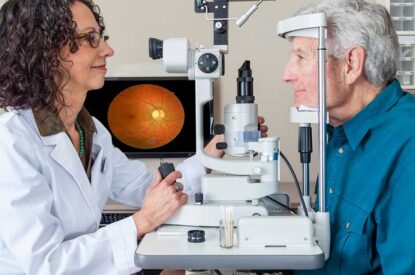Exfoliative Glaucoma
What is Exfoliative Glaucoma?
Glaucoma develops in some patients with a condition called exfoliation syndrome. Exfoliation glaucoma is the most common identifiable secondary form of open-angle glaucoma in the world.
Also known as pseudoexfoliation, this form of glaucoma is caused by the abnormal accumulation of protein in the drainage system and other structures of the eye. This is a type of open-angle glaucoma with unique characteristics and physical findings.
It is more common in certain racial groups including people from Russia, the Nordic countries, Greeks, Mediterranean populations, Indians, and others. A gene abnormality has recently been associated with this particular condition.
As a group, patients with exfoliative glaucoma show higher pressures and faster disease progression than patients with classic primary open-angle glaucoma. The underlying cause is likely due to the abnormal protein and associated pigment blocking the outflow structures in the eye. Although rare, sometimes exfoliative glaucoma can be associated with angle-closure glaucoma.
Video: Exfoliation Syndrome
This brief video explains what Exfoliation Syndrome is, how it contributes to increased intraocular pressure, and the potential for developing glaucoma.
Why is important to know if one has this type of glaucoma?
Patients with exfoliative glaucoma often have more episodes of high pressure, more fluctuations and higher peak pressures than patients with other types of glaucoma. Generally, this kind of glaucoma is more difficult to control with medical therapy. Patients with exfoliative glaucoma often require a more aggressive stepwise therapy and more often need laser, or incisional surgery. Often more frequent visits to their eye doctor are necessary to monitor for disease progression.
Exfoliative glaucoma patients seem to respond well to treatment by selective laser trabeculoplasty (SLT), possibly because of the more pigmented meshwork and a higher concentration of enzymes in the meshwork, termed matrix metalloproteinases, that are activated by laser trabeculoplasty. Patients with this disorder respond well to most types of glaucoma surgery. However, whether or not they respond well to trabecular stent devices or the new generation of tubes to the suprachoroidal space remains to be seen.
Another reason to know whether or not exfoliation is present is that these patients sometimes have increased difficulty with cataract surgery. The abnormal protein seen in this condition settles on and weakens the lens zonules which are suspensory fibers that hold the lens in place. In most patients, the surgical technique can be modified to obtain a good outcome.
Is there any value in genetic testing?
A positive test with many genetically detected diseases can be helpful by suggesting the need for more careful observation. However, in the case of exfoliative glaucoma, the findings from a slit lamp eye exam are often characteristic, and so readily seen (especially when the eye is dilated) that expensive genetic testing may not be necessary or helpful.
Detecting exfoliation may require a dilated eye exam, and is one reason why a dilated eye exam is so important. Individuals over 40 with relatives that have exfoliative glaucoma or of Northern European extraction should be particularly vigilant in having yearly or biyearly eye examinations.
Article by John R. Samples, MD and Tasos Konstas, MD, PhD. First posted May 1, 2013. Last reviewed on January 5, 2023.
Learn More




